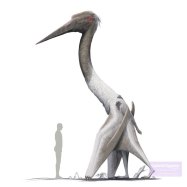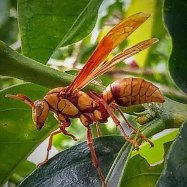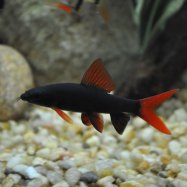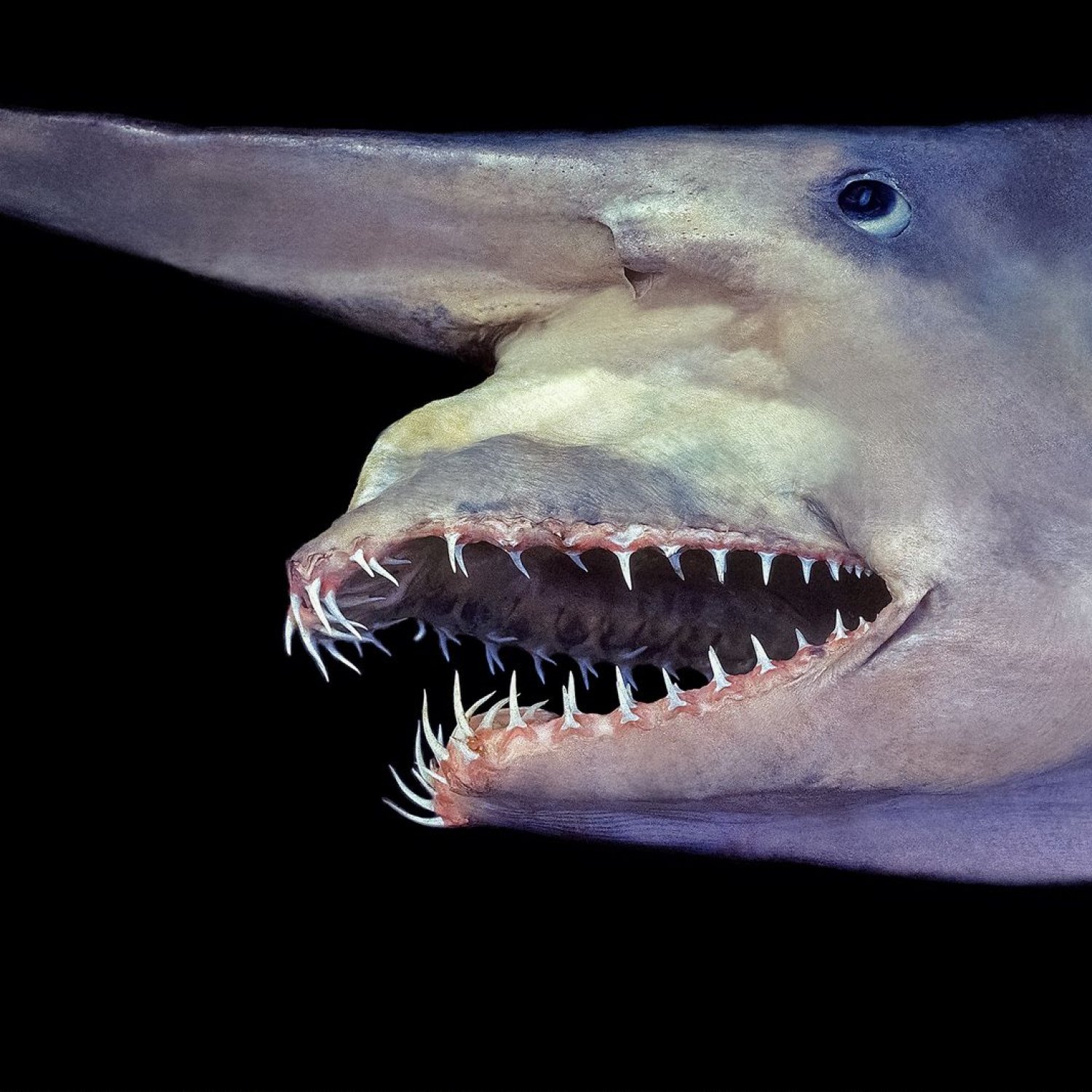
Goblin Shark
Up to 3.8 meters
Did you know the Goblin Shark, with its unique elongated and slender body shape, can grow up to 3.8 meters? Found in the deep sea, this rare species is part of the Mitsukurinidae family. Keep an eye out on your next deep-sea exploration for this fascinating creature. #GoblinShark #DeepSeaExploration #MarineLife
Animal Details Summary:
Common Name: Goblin Shark
Kingdom: Animalia
Habitat: Deep sea
The Mysterious and Enigmatic World of the Goblin Shark
Hidden deep in the depths of the ocean lies a creature that appears to be from another world. With its elongated and slightly eerie body shape, and its striking pink coloration, the Goblin Shark truly stands out among its marine counterparts.But what makes this creature so unique and intriguing? Let's dive deeper and uncover the fascinating features of the Goblin Shark.
A Rare and Mysterious Species
Scientifically known as Mitsukurina owstoni, the Goblin Shark is commonly referred to as 'the living fossil' due to its resemblance to prehistoric sharks Goblin Shark. It belongs to the Chondrichthyes class, meaning it is a cartilaginous fish, and is the only extant species in the Mitsukurinidae family.Endemic to the deep sea, the Goblin Shark remains a rare sight to be seen. It is generally found in the Atlantic, Pacific, and Indian Oceans, with particularly high numbers in Japan, the country of its origin. These creatures are most commonly found at depths of 330 to 1,310 meters, making them almost impossible to spot for the average human being.
A Unique Feeding Method
One of the most distinctive features of the Goblin Shark is its feeding method. Unlike most sharks, which rely on their razor-sharp teeth to capture their prey, the Goblin Shark uses a suction feeding method.Its protruding jaws, which can extend up to 8% of its body length, possess sharp, needle-like teeth that can retract into the mouth when not in use. This unique mechanism allows the Goblin Shark to suck its prey into its mouth, making it a skilled hunter of deep-sea creatures such as squids, fish, and crustaceans.
A Habitat Like No Other
The Goblin Shark is well adapted to its deep-sea habitat Galapagos Shark. Its elongated and slender body shape allows it to move effortlessly in the water, while its pink coloration camouflages it perfectly in the dark depths of the ocean.These creatures are most commonly found in areas with soft sediments such as mud or clay. They have been observed using their elongated snout to dig into the sediment to uncover their prey, making them highly adaptable to their surroundings.
Uncovering the Mysteries of the Deep
The habitats of the Goblin Shark are difficult to access, which has made it a challenge for scientists to study this species. However, thanks to advancements in technology and the use of deep-sea exploration vessels, researchers have been able to capture more footage and information on these elusive creatures.Studies have revealed that Goblin Sharks are slow-moving and solitary creatures, with a lifespan of up to 60 years. They are also known to exhibit sexual dimorphism, with females being larger in size than males.
A Living Fossil with Unique Anatomy
Apart from their feeding method, the Goblin Shark's anatomy sets it apart from other shark species. They possess a specialized organ called the 'ampullae of Lorenzini,' which helps them detect electric currents in the water, making it easier for them to locate their prey.Another unique feature is their retractable jaw mechanism, which allows them to suck in their food with extraordinary speed and force. This is accompanied by an impressive expandable stomach, which enables them to consume large prey items.
A Threatened Species
As with many deep-sea creatures, the Goblin Shark is facing threats from human activities such as deep-sea fishing and pollution. Due to their slow reproductive rate and low population numbers, they are particularly vulnerable to these threats.Conservation efforts are underway to protect these unique creatures, with a focus on regulating deep-sea fishing and creating marine protected areas. However, more research is needed to fully understand the biology and ecology of Goblin Sharks and the impact of human activities on their population.
The Fascinating World of NLP and its Connection to Goblin Sharks
The mysterious and enigmatic nature of the Goblin Shark has captivated human interest for centuries. However, with advancements in technology, we are now able to uncover even more information about these elusive creatures.One such technology is Natural Language Processing (NLP), a field of study that focuses on the interactions between computers and human (natural) languages. By analyzing vast amounts of data and text, NLP can help us gain a deeper understanding of animals such as the Goblin Shark.
For instance, researchers can use NLP to analyze text data from scientific articles, blogs, and social media posts to identify the geographical distribution and threats faced by the Goblin Shark. This can provide valuable insights for conservation efforts and help raise awareness about this unique species.
The Goblin Shark: A Marvel of the Deep Sea
The Goblin Shark has proven to be a marvel of the deep sea, with its unique and mysterious features. Its elusive nature, coupled with its adaptation to the deep-sea habitat, truly sets it apart from any other species.As we continue to learn more about these creatures, it is imperative that we work towards their conservation and protection. Only then can we ensure that this pink-tinged living fossil continues to thrive in the depths of the ocean, and remain a fascinating mystery for generations to come.

Goblin Shark
Animal Details Goblin Shark - Scientific Name: Mitsukurina owstoni
- Category: Animals G
- Scientific Name: Mitsukurina owstoni
- Common Name: Goblin Shark
- Kingdom: Animalia
- Phylum: Chordata
- Class: Chondrichthyes
- Order: Lamniformes
- Family: Mitsukurinidae
- Habitat: Deep sea
- Feeding Method: Suction feeding
- Geographical Distribution: Atlantic, Pacific, and Indian Oceans
- Country of Origin: Japan
- Location: Deep sea
- Animal Coloration: Pink
- Body Shape: Elongated and slender
- Length: Up to 3.8 meters
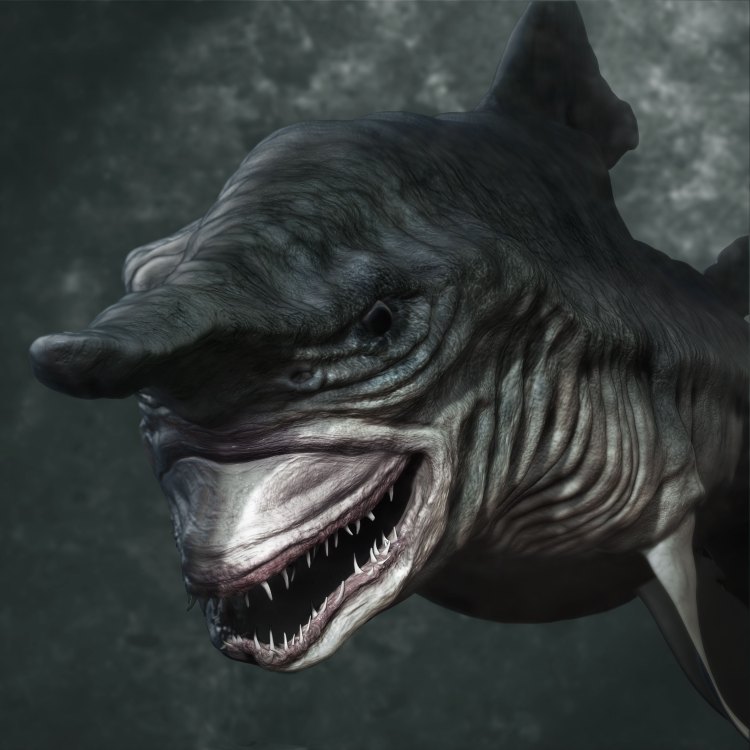
Goblin Shark
- Adult Size: 2.3-3.8 meters
- Average Lifespan: Up to 35 years
- Reproduction: Ovoviviparous
- Reproductive Behavior: Unknown
- Sound or Call: Unknown
- Migration Pattern: Unknown
- Social Groups: Solitary
- Behavior: Slow-moving and elusive
- Threats: Overfishing and habitat destruction
- Conservation Status: Vulnerable
- Impact on Ecosystem: Apex predator
- Human Use: Rarely targeted by fisheries
- Distinctive Features: Prominent snout and retractable jaws
- Interesting Facts: Goblin Sharks have a unique jaw structure that allows them to protrude their jaws forward to capture prey.
- Predator: Unknown
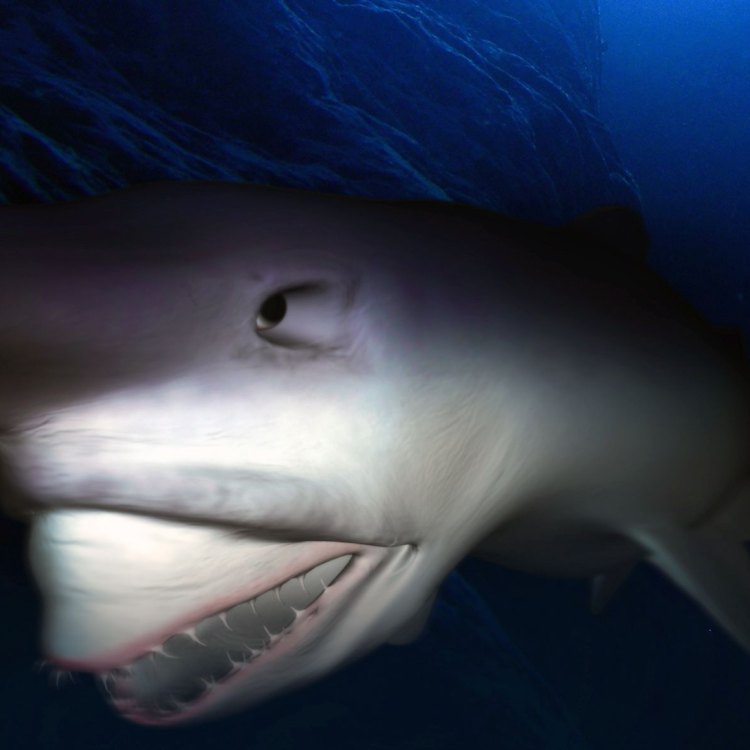
Mitsukurina owstoni
The Fascinating World of the Goblin Shark: A Rare and Elusive Apex Predator
Deep below the ocean's surface, in the dark and mysterious depths, lies a creature that eludes human understanding and fascinates us with its unique features. The Goblin Shark, scientifically known as Mitsukurina owstoni, is a rare and elusive deep-sea shark that has captured the imagination of marine biologists and enthusiasts alike.With its distinctive appearance and elusive nature, the Goblin Shark has only recently been discovered and studied, making it one of the most fascinating and mysterious sharks in the world. In this article, we will delve into the world of the Goblin Shark, exploring its physical characteristics, behavior, and impact on the ecosystem PeaceOfAnimals.Com.
The Physical Characteristics of the Goblin Shark
The Goblin Shark, also known as the "living fossil," is a species of shark that has remained relatively unchanged for millions of years. It can be found in the deep waters of the Atlantic, Pacific, and Indian oceans, typically at depths of 330 to 4,265 feet.One of the most distinctive features of the Goblin Shark is its prominent snout, which resembles a goblin's nose. This unique snout is lined with electroreceptors, allowing the shark to sense the electrical fields produced by its prey.
Another defining feature of the Goblin Shark is its retractable jaws. Unlike most shark species, the Goblin Shark's jaws can protrude forward to capture prey, making it an incredibly efficient predator. Its jaws can extend up to 3% of its length, which is a unique adaptation that sets it apart from other sharks.
The Goblin Shark's skin is a pale pinkish-gray color, making it easily camouflaged in the deep-sea environment. It also has a soft and flabby body with a flattened head, giving it a distinct appearance from other shark species Glen Of Imaal Terrier.
The Mysterious Behavior of the Goblin Shark
With its elusive nature and deep-sea habitat, very little is known about the behavior of the Goblin Shark. It is believed to be a solitary and slow-moving species, commonly found in the depths of the ocean. Due to its lack of natural predators and slow movements, the Goblin Shark does not need to expend much energy, making it less active than other shark species.The reproductive behavior of the Goblin Shark is still a mystery to scientists. They are ovoviviparous, meaning their young hatch from eggs inside the female's body and are then born live. However, little is known about the specific mating and birthing habits of these enigmatic creatures.
It is also unknown if the Goblin Shark produces any sounds or calls, as they have never been observed making noise. However, it is believed that they might use their electroreceptors to communicate with other sharks and find potential prey.
The Impact of the Goblin Shark on the Ecosystem
Despite its elusive nature, the Goblin Shark plays an essential role in maintaining the balance of the deep-sea ecosystem. As an apex predator, it regulates the population of its prey, preventing them from overpopulating and causing harm to the ecosystem.One of the key threats to the Goblin Shark is overfishing, as it is often caught as bycatch in deep-sea fisheries. This species is also highly vulnerable to habitat destruction caused by deep-sea mining and other human activities. As a slow-growing and long-lived species, these sharks cannot replenish their population at the rate at which they are being caught, putting them at risk of extinction.
Human activities not only directly impact the Goblin Shark, but they also indirectly harm its ecosystem. With its role as an apex predator, the loss of the Goblin Shark can cause a ripple effect throughout the food chain, ultimately affecting the balance of the entire ecosystem.
The Goblin Shark and its Interaction with Humans
The Goblin Shark is rarely encountered by humans, and there have been no known attacks on humans by this species. Due to its deep-sea habitat and elusive behavior, it poses little risk to humans. However, this has not stopped humans from being fascinated by this mysterious creature.While the Goblin Shark is not targeted by fisheries, it is often caught as bycatch in deep-sea trawl fisheries. Fortunately, due to its low rate of reproduction compared to other shark species, the Goblin Shark is not at risk of being overfished on a large scale.
Interesting Facts about the Goblin Shark
Despite being a relatively unknown and elusive species, the Goblin Shark has fascinated scientists and marine enthusiasts with its unique characteristics. Here are some interesting facts about this living fossil:- The Goblin Shark was first discovered in 1897 by a Japanese scientist, Kakichi Mitsukurina, who named the species after himself.
- The Goblin Shark is thought to live up to 35 years in the wild, making it one of the longest-lived shark species.
- They are known to feed on a wide range of prey, such as deep-sea fish, crustaceans, and even other sharks.
- The unique jaw structure of the Goblin Shark is believed to be an adaptation to its deep-sea environment, where prey is scarce, and capturing food requires precision and speed.
- Despite its fearsome appearance, the Goblin Shark poses no threat to humans and remains an elusive and mysterious creature.
In Conclusion
The Goblin Shark is a truly fascinating creature that has perplexed scientists and captured the imagination of many. With its unique physical features, elusive behavior, and vital role in the deep-sea ecosystem, it is a species that demands our attention and protection.As we continue to explore and exploit the ocean's resources, we must remember that these waters are home to many remarkable and mysterious creatures like the Goblin Shark. It is our responsibility to ensure their survival for future generations to witness and marvel at these amazing beings.

The Mysterious and Enigmatic World of the Goblin Shark
Disclaimer: The content provided is for informational purposes only. We cannot guarantee the accuracy of the information on this page 100%. All information provided here may change without prior notice.



